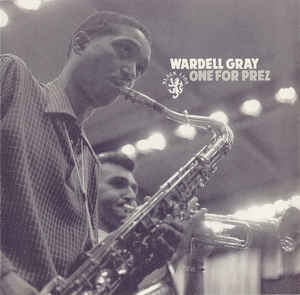Dell's Bells – Wardell Gray
An elegant bebop head full of unpredictable rhythms, recorded at Wardell Gray’s first session as a leader. Based on the changes of What Is This Thing Called Love?, it has a six-measure intro with snappy rhythm section figures.
- Recording: Wardell Gray - One For Prez
- Recorded on: November 23, 1946
- Label: Black Lion (60106)
- Concert Key: C
- Vocal Range: , to
- Style: Swing (medium up)
- Tenor Sax - Wardell Gray
- Piano - Dodo Marmarosa
- Bass - Red Callender
- Drums - Harold “Doc” West
0:00
0:00
Buy MP3
Video
- Description
- Historical Notes
- Solos
- Piano Corner
- Bass Corner
- Drum Corner
- Guitar Corner
- Inside & Beyond
- Minus You
This medium-up swinger is in a classic bebop style, full of unpredictable, exciting rhythms. It’s based on the changes of the Cole Porter standard What Is This Thing Called Love?, but takes quite a different approach than Hot House, Tadd Dameron’s classic bebop head on the same changes. The rhythms in Dell’s Bells are varied and erratic, not regular and riff-like as in the theme of Hot House. The smooth melodic contours give Dell’s Bells an elegant, refined quality despite the irregular rhythms.
The first measure of the A section melody runs down an unaltered C7 scale, quite a contrast to the many interpretations of these changes that begin with Gm7♭5 followed by C7 with various altered upper extensions. Later on, the melody uses several upper extensions over dominant chords, such as the 13-3-♭9 structures over G7 in the sixth measure of the A section and F7 in the second measure of the bridge. Several places in the melody have a phrase structure which is surprisingly common in early bebop: two repeated eighth notes at the beginning of a downward run.
There is a snappy rhythmic intro, six measures long and full of rhythm section figures. This is set up by a measure of time in the drums alone as a one-measure pickup. There’s also a coda which replaces the last two measures, with the rhythm section holding out a final chord on beat 4 of the last measure.
On the recording, the piano doubles the tenor sax melody an octave higher. The 5th and 6th measures of the bridge melody are played by the piano alone; these were probably improvised on the recording, as they are different on the alternate takes, but they certainly fit well with the rest of the melody.
The first measure of the A section melody runs down an unaltered C7 scale, quite a contrast to the many interpretations of these changes that begin with Gm7♭5 followed by C7 with various altered upper extensions. Later on, the melody uses several upper extensions over dominant chords, such as the 13-3-♭9 structures over G7 in the sixth measure of the A section and F7 in the second measure of the bridge. Several places in the melody have a phrase structure which is surprisingly common in early bebop: two repeated eighth notes at the beginning of a downward run.
There is a snappy rhythmic intro, six measures long and full of rhythm section figures. This is set up by a measure of time in the drums alone as a one-measure pickup. There’s also a coda which replaces the last two measures, with the rhythm section holding out a final chord on beat 4 of the last measure.
On the recording, the piano doubles the tenor sax melody an octave higher. The 5th and 6th measures of the bridge melody are played by the piano alone; these were probably improvised on the recording, as they are different on the alternate takes, but they certainly fit well with the rest of the melody.
Wardell Gray’s sidemen on this session were all quite active on the Los Angeles scene at the time. Pianist Dodo Marmarosa was a member of Artie Shaw’s big band from 1944 through most of ’46. In the fall of the latter year he also recorded with his own trio, trumpeter Howard McGhee’s sextet, and several other big bands including a memorable session co-led by composers Ralph Burns and George Handy, issued on the Clef compilation “The Jazz Scene.” Bassist Red Callender was also on this big band session; at the time he was mostly working with Louis Armstrong, with whom he played on the soundtrack of the movie “New Orleans.” Drummer Harold “Doc” West is slightly less well-known; in 1946 he also recorded with vocalists Leo Watson and Al Hibbler. Both Callender and West recorded on Charlie Parker’s classic session of February 19, 1947, with Erroll Garner on piano.
Related Songs
Email Send Dell's Bells to a friend
Send this page to a friend via email. Add your name or email in the first field. In the second, add one or more email addresses, separated by a comma.

Wardell Gray
February 13, 1921 – May 25, 1955
Though sometimes overlooked, even to this day—perhaps due to his all-too-brief career or his extensive work in swing big bands —Wardell Gray was among the most important jazz musicians of the bebop era. He was one of the first tenor saxophonists, along with Dexter Gordon , Gene Ammons, and Lucky Thompson, to establish an original voice on the instrument in the bebop style. Read more...
There was a problem.
...

